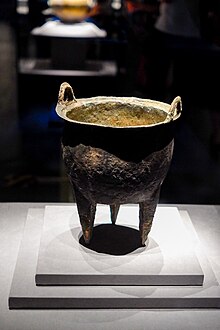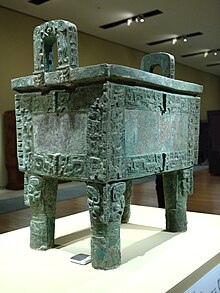Ding (vessel)
They were made in two shapes: round vessels with three legs and rectangular ones with four, the latter often called fāng dǐng (Chinese: 方鼎; lit.
The earliest recovered examples are pre-Shang ceramic ding at the Erlitou site,[1] but they are better known from the Chinese Bronze Age, particularly after the Zhou deemphasized the ritual use of huangjiu alcohol practiced by the Shang kings.
[4] Subsequently, imperial authority was represented by the Heirloom Seal of the Realm, carved out of the sacred Heshibi; it was lost at some point during the Five Dynasties after the collapse of the Tang.
[6] The sacrifices were meant to appease ancestors due to the Shang belief that spirits had the capability to affect the world of the living.
He believed that their over-consumption of wine led their king to lose the Mandate of Heaven, thus leading to the downfall of the Shang dynasty.
"[2] This theory suggests that because there was a change in decor as well as the types and variations of vessels found in tombs, their function shifted from solely religious to a more secular one.
Next, a negative of this is made by adding a layer of wet clay to the completed model and allowed to harden to the point where it can still be cut away from it.
[10] A newer variation on the piece mold process was put forth as a way to explain asymmetrical faces on vessels which, as a rule, should be symmetrical.
In this technique, soft, liquid clay would be put into a leather bag and piped onto a surface through some kind of very fine tube made of metal or bone.
Arguably, the most frequent, though also the most intriguing and mysterious[citation needed], form of décor is the two eyed motif, often referred to as the taotie.
This motif can range from as simple as two protruding half spheres in an otherwise featureless plane to as complex as highly detailed mask-like faces with various animal features such as snouts, fangs and horns.
In these backgrounds, a whirl or thunder pattern, a low relief spiral design, is used to fill the space and create a texture across the surface of the vessel.
[16] In later centuries, fully formed three-dimensional animal figures, such as cows, goats, birds, dragons, and lions, were occasionally included on bronze vessels.
Wang for the first time has gone on to emulate his august deceased-father, respectfully morning and night taking out and bringing in the king's commands, not daring not to follow through or to manage.
[26] Western Zhou ding vessels departed from the Shang aesthetic in terms of their oddly-proportioned legs that were deliberately emphasized through the addition of flanged taotie motifs.
[28] Inscriptions cast on Western Zhou ding vessels, for example, commemorate political events and record gifts between monarchs and subjects.
[32] In later times, in the middle Warring States period, the three-legged ding would be one of the most popular ceramic forms imitating bronzes.







